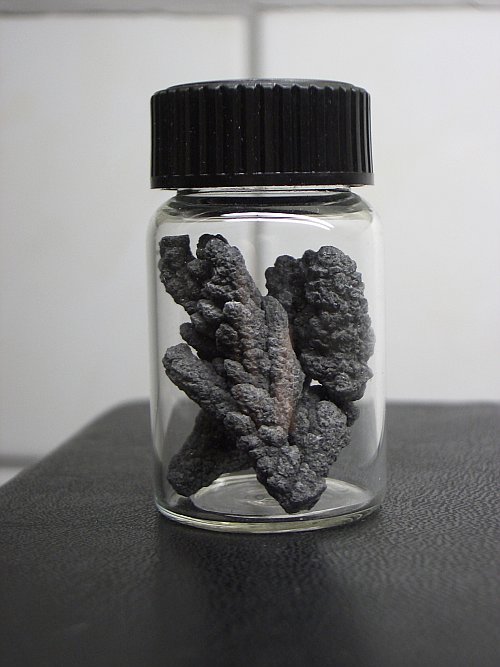


Arsenic
 Arsenic exists in several allotropic forms. The most
stable form at room temperature is the so-called 'metallic' form, which is a
grey solid, with some metal-like lustre. Arsenic is a fairly non-reactive
element, which is not attacked by water, non-oxidizing dilute acids or dilute
alkalies. It, however, dissolves in nitric acid, forming arsenious acid (H3AsO3),
or arsenic acid (H3AsO4), depending on the concentration
and the temperature of the nitric acid. It also dissolves in concentrated hot
sulphuric acid.
Arsenic exists in several allotropic forms. The most
stable form at room temperature is the so-called 'metallic' form, which is a
grey solid, with some metal-like lustre. Arsenic is a fairly non-reactive
element, which is not attacked by water, non-oxidizing dilute acids or dilute
alkalies. It, however, dissolves in nitric acid, forming arsenious acid (H3AsO3),
or arsenic acid (H3AsO4), depending on the concentration
and the temperature of the nitric acid. It also dissolves in concentrated hot
sulphuric acid.
Arsenic and its compounds are very toxic for humans and for the environment and for this reason, it is hard for the general public to obtain compounds of this element. In the past, arsenic compounds were used as poison for rats and insects, but this use is abandoned for quite some time already and no other consumer-applications are left for the element and its compounds.
The chemistry of arsenic is of limited interest for the home chemist. In aqueous solution, soluble arsenic compounds usually are colorless, and its aqueous coordination chemistry also is fairly limited. Compounds of arsenic contain the element in its +3 oxidation state, or its +5 oxidation state. Most common are the compounds As4O6 (called 'arsenic trioxide', frequently erroneously written as As2O3) and As4O10 (called 'arsenic pentoxide', frequently erroneously written as As2O5).
Arsenic trioxide is an extremely poisonous white solid, which is only very sparingly soluble in water. It is known already for a very long time. In medieval times it was the favorite poisoning agent. Arsenic trioxide is a mild reductor, but on the other hand, it also is fairly easily reduced itself to elementary arsenic.
The trioxide easily dissolves in concentrated hydrochloric acid, giving rise to formation of arsenous acid, H3AsO3, and arsenic trichloride. Such solutions can easily be reduced to elemental arsenic by reducing agents like tin(II) chloride, or sodium hypophosphite.
Arsenic pentoxide also is an extremely poisonous white chalk-like solid. It seems to be almost insoluble in water, like arsenic trioxide, but in reality it is very soluble in water. The remarkably property of this compound is that it dissolves to a really large extent (in 100 grams of water much more than 100 grams of arsenic pentoxide can be dissolved), but it dissolves very slowly. It takes hours, or even days to dissolve some of the solid in water at room temperature, but lots of it can be dissolved. The solution contains arsenic acid, H3AsO4, which is a somewhat weaker acid than phosphoric acid. Arsenic pentoxide and arsenic acid are fairly strong oxidizers, but these also are slow acting oxidizers. Iodine and bromine are released from iodides and bromides, especially at low pH and higher concentration. Even chlorine can be released from concentrated hydrochloric acid, but this reaction is very slow.
In acids, arsenic pentoxide also can be dissolved, but this process is as slow as in plain water. In alkaline solutions, arsenic pentoxide dissolves more easily, giving rise to arsenates.


If one decides to experiment with arsenic or its compounds, then one has to be very careful with strong reducing agents in combination with acids (e.g. zinc metal in acid, magnesium powder, borane-based reductors). Under such conditions, both arsenic(III) and arsenic(V) compounds can easily be reduced beyond elemental arsenic to arsenic(-III) as arsine, which has formula AsH3. This is a colorless flammable gas, which is outrageously poisonous. A few ml of this gas can kill a grown-up person. This is a very serious risk, which makes the use of arsenic compounds in a home-lab a real no-go, unless very strict safety measures are taken.
If you really want to experiment with arsenic compounds, then perform a thorough risk assessment before conducting any experiments! Any risk of production of arsine must be recognized, and proper precautions must be taken. Failing to do so may result in serious poisoning. Also beware, arsenic compounds may have cumulative effects and recently strong evidence is found that it has carcinogenic properties as well.